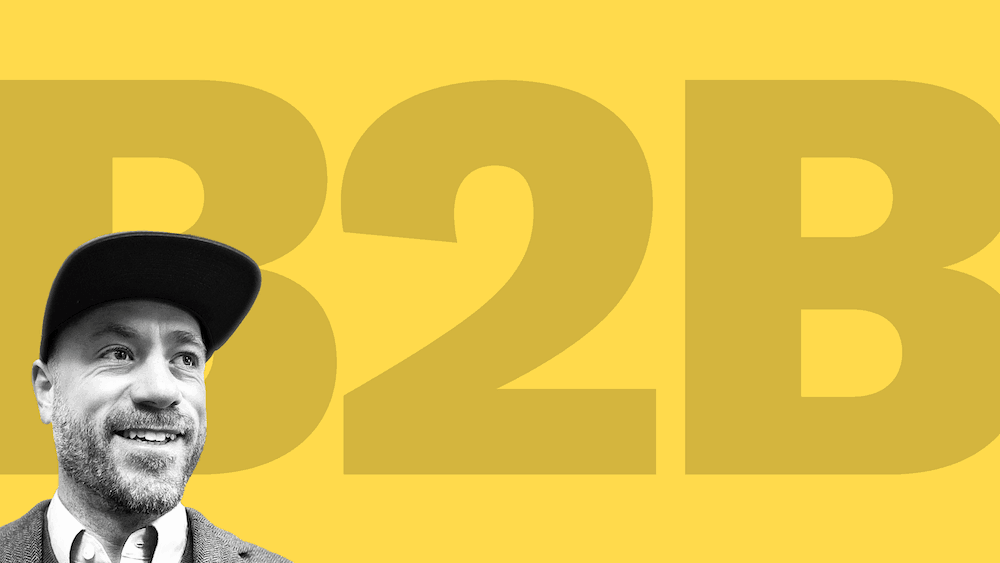
I’m guessing you’re on the hunt for a reliable B2B marketing strategy.
Well, it’s your lucky day. That’s exactly what you’re going to get if you read this guide thoroughly.
But, before we start, a little about me so you know who’s dishing out this marketing advice. I’m the head brand mechanic at a demand generation agency called Special Sauce. I also put out a weekly marketing-focused email called The Recipe that simplifies complex branding and marketing topics.
The advice in this guide is not theory. This is a tested and proven system I’ve used to grow my business (not to mention all of my clients in the business-to-business space who have ridden this system to the promised land).
Sure, I work with select B2C companies, but I love B2B marketing because it’s more predictable. The B2B market doesn’t live on the fickle tastes of 14-year-olds. Justin Bieber and Taylor Swift aren’t influencing purchasing decisions for business buyers. The purchase motivations of businesses are easier to understand.
Businesses want to make money.
I know your buyers are more complex than that, but understanding this stupid simple principle is a solid foundation for a sturdy business. Now, let’s get into this B2B marketing guide…
Introduction: What Is B2B Marketing
Business-to-business marketing is taking the right people in the right companies from awareness that you exist to raving fan customers. The goal of b2b marketing is to:
- Get existing customers to buy more.
- Attract more new customers.
Sounds simple enough, and it is with a solid strategy and consistent execution. This guide will give you the strategy and explain how to execute it. You just have to do the work.
Complete the designated action items as you finish reading each chapter to get the most out of this guide. You’ll walk away with a functional plan you can put to work.
Chapter 1: Build Social Proof
Before we start pushing out miraculous content that entices the pants off potential customers, we need to make sure the customers we have are happy. As they say, one customer in hand is worth two scrolling through their feed on LinkedIn. I doubt anyone has actually said that, but you get the idea.
Make sure you’re delivering results, getting repeat business, and landing a few referrals before you worry about chasing cold prospects. It’s impossible to grow a healthy business on a constantly churning customer list. Tackle the steps in chapter 1 to lay the foundation for a badass business, not just a stellar marketing plan.
Solve Problems
Businesses pay other businesses money to solve a problem, prevent a problem, or fill a void. This is true whether you’re a CPA firm, PR firm, law firm, branding firm, SAAS product, manufacturer, or a cleaning company. I’m not hiring you to give me a block of hours, I’m hiring you to get me out of this legal mess, do my taxes, streamline my project management, manufacture the perfect product, or to make my toilet look like a porcelain throne.
Great marketing is useless if you can’t deliver results for people that hire you. Think of it like this,
Marketing is pouring fuel on the fire, but your product is the fire.
Solving problems and delivering results is the spark that ignites your fire. I’m out of fire metaphors so I hope you’ve got the gist of the message.
Focus on becoming great at what you do for the businesses that have already hired you before you worry about selling it to other people. The best way to get really good at anything is to repeatedly do the same thing.
If every project you take on is different…
- You’ll struggle to gain any scale in your business.
- You’ll constantly be fighting to find new work and never build a reputation for anything specific.
- You’ll have a hard time vocalizing your Unique Selling Proposition (USP).
Be predictably excellent in something specific by having a repeatable system that gets results for B2B customers. This might seem like odd advice in an article about B2B marketing, but it’s crucial for driving repeat business and referrals.
A product or service that delivers results is the best marketing you’ll ever create.
You may not think of your product as marketing, but it is. Seth Godin wrote an entire book on this exact subject called This Is Marketing. It’s worth a read if you want some inspiration from another bald guy.
The easiest way to judge whether you’ve got a solid product is to measure your referral and repeat business rate. When you’re getting referrals and repeat business…
- You can identify who is (and who isn’t) the right customer for your business.
- You’ll be able to vocalize the problem you solve for these customers.
- You can charge more because the results you deliver are in demand.
- You have a revenue base to build on instead of continuously starting over.
- You know it’s time to pour fuel on the fire with marketing intended to attract new customers.
In other words, delivering results is the first step toward a successful B2B marketing strategy and a thriving business.
Professional Follow Up Sequence
Once you’re solving problems and killing it for customers, collect testimonials and Google reviews. Testimonials and reviews provide social proof to prospects considering your business. These testimonials proving you’ve delivered for other businesses in the past are highly persuasive.
But how do you get people to say wonderful things about your business? It’s all in how you ask (assuming you delivered results). Institute a professional follow up sequence and you’ll see an immediate spike in client feedback. I use a proprietary system called ClientSaid.
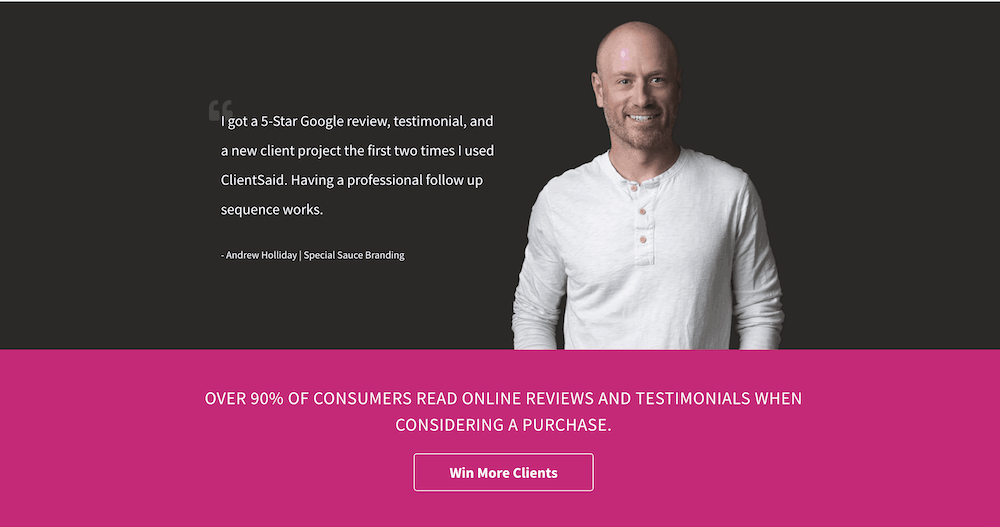
ClientSaid is a ridiculously easy way for me to build a professional follow up sequence that does all of the heavy lifting. All I have to do is send a link to my screening page (where customers rate us on a 1-5 star scale). The system will prompt my client through either giving feedback (if they rate us 1-3 stars) or providing a testimonial (if they rate you 4-5 stars). Either way, my customer is prompted for an appropriate action based on their rating of our services.
Here’s the screen that greets my clients after every Special Sauce project…
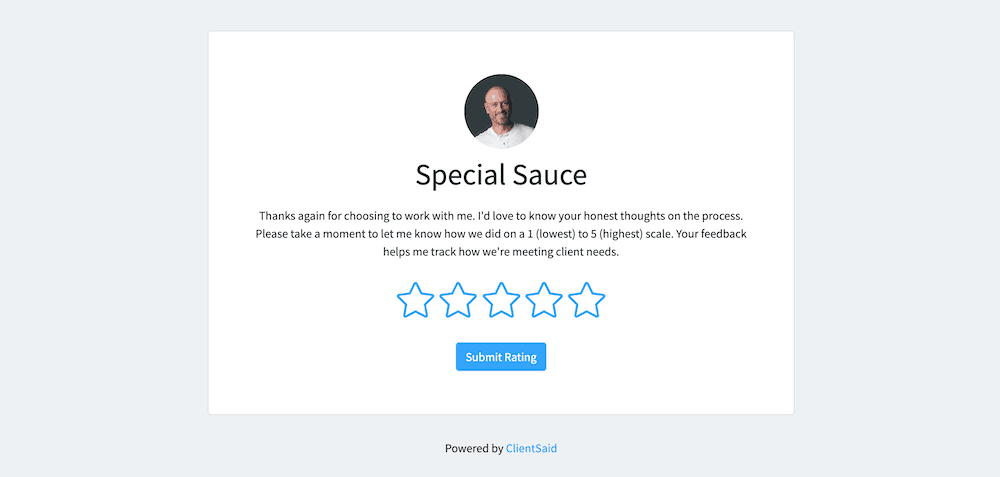
I send a simple email as soon as the project is complete asking clients to take 3 minutes to let me know how we’re doing. I explain that I value their feedback and would greatly appreciate their thoughts. This is all true, but I also want them to have an easy method for providing a testimonial or review if they feel so inclined.
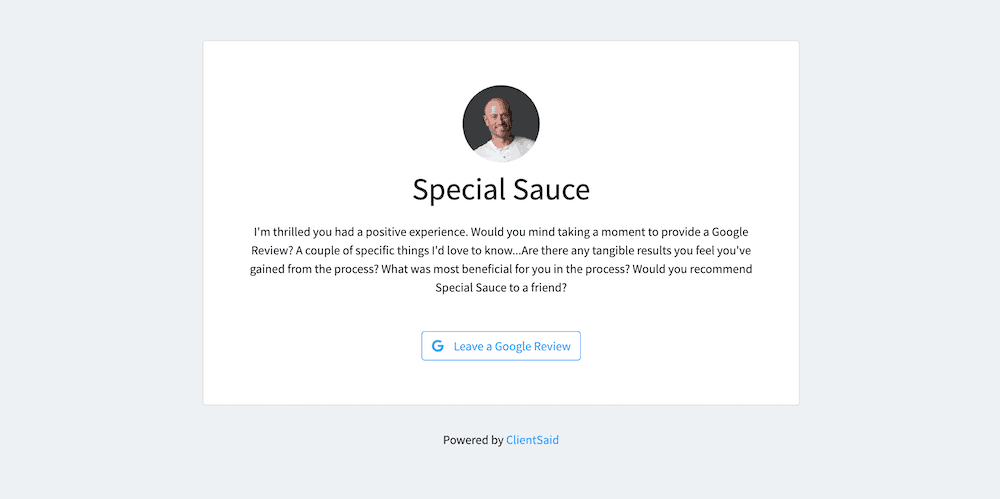
This approach of sending clients an email and letting a third party system then prompt them for a testimonial or review is far more effective than the alternative.
What’s the alternative?
Sending an email and hitting people up directly for a testimonial or review. Sure, this is ok for close friends or well-established contacts, but it’s unprofessional and presumptuous in other cases. You come across like the desperate boyfriend who is always asking for something.
Like everything else you do, this process should be focused on your customer. Obsess on their happiness and satisfaction. Let a third party system do the testimonial and review asking for you. I’m willing to bet you’ll build a powerful bank of social proof in a short amount of time if you follow this advice.
Once you have a bank of testimonials and reviews, put them to use on your website.
Everyone lands on your website hoping you have the answer to their problem. They’re skeptical but hopeful at first. Testimonials reassure these website visitors that you’ve solved this problem before so you can do it for them as well.
The only way to grow your company is to get more business from existing customers, charge more, or get more new customers. This chapter sets you up for getting more work from existing customers as well as charging more. The following chapters will lay out the process for adding new businesses to the customer list.
Chapter 1: Action Items
- Document your process. Systematize your product or service delivery to efficiently solve the same problems repeatedly. Write down the exact steps you take to get results so you (or your team) can successfully replicate them time and again.
- Build a professional follow up sequence you use after every project. There are several systems out there now, but feel free to ask about our proprietary ClientSaid system if you’re interested.
- Collect social proof (testimonials and Google reviews).
- Put the social proof on your website and in your marketing.
Chapter 2: Clarify Your Brand Message
“The USP is the nucleus around which you build your success, fame, and wealth. So you’d better be able to state it. If you can’t state it, your prospects won’t see it. Whenever a client needs the type of product or service you sell, your USP should bring you or your company immediately to mind. Clearly conveying the USP through your marketing and business performance will make business success inevitable. But you must boil down your USP to its bare essence.”
― Jay Abraham
What do you do?
You’ll get that question hundreds of times this year. Will you stumble all over yourself trying to answer?
Most B2B companies answer with something along the lines of, “We’re a _______” or “I’m a ______.”
Who cares?
That’s what people are thinking when they hear your bland line. The answer to this question should center around the business you want as a client and the problem you solve for them, not you.
We’re all selfish people. Our instinct for self-preservation and survival makes us filter messages to find what’s in it for us.
The business-to-business market is no different. A person is always buying on behalf of their employer or business. You must identify who that person is, the problem they have, how you can help them solve that problem, and what makes you a better option than anyone else. That’s how you land their business.
As Jay Abraham’s quote above states, conveying a clear Unique Selling Proposition (USP) will make business success almost inevitable. The easiest way to identify and vocalize that USP is to write a script. Yes, I mean literally build a script to memorize.
Complete These Brand Script Prompts:
Our Customer Is…
They Struggle With…
We Help Them By…
The One Thing That Makes Us Different Is…
A script provides structure for your business, brand, and marketing. You identify your customer, define their problem, solidify your solution, and vocalize your differentiator in four steps. Now cut it down to a single sentence we call your brand one-liner.
You’ll use your brand one-liner on your website, social media profiles, in marketing, and in every form of conversation from sales presentations to cocktail parties. It’s an easy way to vocalize your USP so that it’s consistently conveyed. Use this prompt to focus your brand one-liner around your customer.
Write Your Brand One-Liner:
We help ____________ do ________________.
Notice this prompt is focused on who you help and what you do for this business, not pitching your product or service. Here’s an example of how the brand one-liner and brand script fit together using my company, Special Sauce:
We help B2B brands grow with a persuasive message and the right marketing.
Here’s what the brand script looks like that’s at the base of this one-liner:
Our Customer Is = B2B Companies
They Struggle With = Confusion about who to target, what to say, and where to focus marketing efforts to drive growth.
We Help Them By = Charting a course to go from where they are today to where they want their business, brand, and marketing to be in two years.
The One Thing That Makes Us Different = Our proprietary 1 month Brand Recipe™ process we use to help clients identify the ideal people to target, clarify their brand message, and define the right marketing strategy to drive growth.
Take a minute to open another window and pop over to the Special Sauce home page, about page, services page, and case studies pages and you’ll see our script weaved throughout our website. We practice what we preach because it works. In case you’re still doubting the importance of a clear USP, let’s look at one more example.
B2B Unique Selling Proposition Example
Clarifying your message will help you make money. That’s a fact. Take a look at Slack for a little proof. We didn’t have anything to do with Slack’s communication strategy so everything that follows is our outside observation, but it’s obvious someone in the company thoroughly grasps the idea of the USP. Here’s their website homepage…

Slack doesn’t dance around their USP. It smacks you in the face three times above the fold on their website. In case you missed it…
Slack replaces email.
Making this USP impossible to ignore has led them to hundreds of millions of dollars.
Whether you’re a publicly-traded company or a solopreneur, the ability to vocalize your USP will dictate future growth.
Chapter 2: Action Items
- Clarify your message with a brand script.
- Boil your USP down to its bare essence with your brand one-liner.
- Weave your brand script throughout your website and marketing to present a consistent message.
Chapter 3: Define Your Business Goals
A friend of mine is starting a business that requires an enormous upfront investment. We’re talking eight figures to open the doors. He shared their marketing plan with me last week. The marketing plan was provided by the branding firm they engaged to get things up and running.
Long story short, the plan was like an Instagram influencer: pretty, but worthless.
The presentation of the plan was flawless. Every page had been custom designed and it looked truly beautiful. The problem was that it wasn’t actually a marketing plan. The ‘plan’ lacked an actual marketing strategy. After a little conversation, the problem jumped out at me.
This branding firm doesn’t know anything about my friend’s business. They didn’t ask the lifetime value of a customer, they don’t know how much the product/service costs, they have no clue how many customers they’re trying to acquire before launch, and they certainly don’t know the long term goals of the business.
There’s no way to build and execute a successful marketing strategy without knowing what you’re trying to achieve.
The purpose of marketing is to move you closer to your business goal. To do this, you must first define your business goals. That’s putting a big red X on where you want to go. With the destination in hand, you can chart a course that will get you to the promised land.
Starting with tactics instead of a goal is a quick way to waste a lot of time and money. You’re just shooting arrows in every direction and hoping they hit a customer. You don’t really know why you’re doing the various marketing tactics, you’re just hoping they work.
Contrast this with a methodical approach that defines where you want your business to be in 2 years. I specifically use 2 years with every client because it’s far enough into the future that you’re not worried about the fires of the day, but it’s close enough to feel tangible.
Your 2-year vision translates into specific and measurable business goals. Business goals can then be translated into the tactics that make up a marketing funnel (which we’ll talk about in Chapter 4).
Chapter 3: Action Items
- Vocalize where you want your business to be in exactly two years from today so you can chart a course that will get you there:
- What is your revenue?
- How does revenue break down between products?
- Who are your customers?
- How many customers do you have?
- How much is each customer worth (what’s their lifetime value)?
- What problem is your company known for solving?
- Set specific and measurable milestones to hit on the path to your 2-year goals. These milestones will allow you to remove emotion and honestly assess whether you’re moving toward your desired destination.
Chapter 4: Set Up A B2B Marketing Funnel (well, it’s like a funnel but better)
A business-to-business marketing funnel is the process you use to take someone from awareness that you exist to raving fan customer. We use a spin on the classic AIDA model (Attention – Interest – Desire – Action).
The Special Sauce variation is modified from a dead-end funnel into a perpetual wheel. It’s built to execute a value-driven content marketing strategy where we will keep nurturing our audience with value even after they’ve purchased. Don’t worry if this sounds like a foreign language at the moment, we’re going to walk through each step of the AITAR model (haha, AITAR kinda sounds like a ship name on Star Wars).
The Special Sauce Content Marketing Wheel.
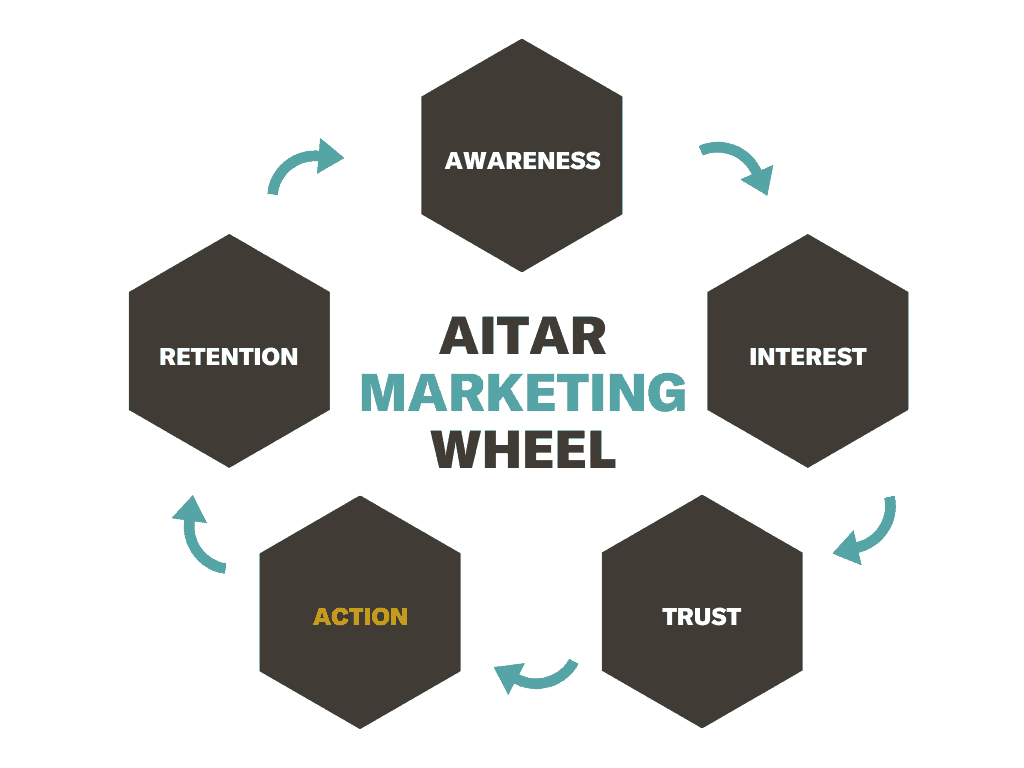
Awareness
Regardless of what industry you’re in or what goals you have, growing an audience is the first step to a steady flow of new business walking in your door. We’ll build a lucrative audience by grabbing attention from the right people and making them aware that you exist.
Interest & Trust
Once they’re on your wheel, you can earn their email and nurture them along with badass content that builds interest and trust.
Action
We keep showing up every single week with juicy nuggets of value specifically for our audience. When they feel all warm and comfy with your expertise, they’ll take action and you’ll get the sale.
Retention
Marketing doesn’t stop with the sale (as we discussed in Chapter 1), solve their problem to turn them into raving fans who preach about your business to their friends. Keep sending value every single week to retain their attention and interest. You want your business top-of-mind any time they (or a colleague) have a need.
When you master each step of the wheel, you’ll have an unstoppable marketing machine that keeps rolling out new business.
Again, the key to this strategy is to build an audience. I’m not saying you need to have tens of thousands of people in your audience to have a successful marketing system, but you do need a dedicated community who want your content.
For this reason, our marketing system is centered around b2b content marketing. This is a specific methodology that we’ve put into place for numerous clients… because it works.
I choose to ignore Instagram, TikTok, Pinterest, Twitter, and countless other social media and marketing channels in this guide. These are all viable marketing channels that work great for some businesses, but the most common issue we see in failed B2B marketing attempts is trying to tackle too many channels.
Our goal is to be consistently exceptional on a couple of highly valuable channels. This guide takes a less of everything, but more of the right things approach. I’m confident that our AITAR marketing wheel can help any B2B company get results from your marketing (if you do the work).
Here’s how you get your AITAR marketing wheel rolling…
Pick your B2B Content Marketing Engine
Will you commit to writing, video, or audio as the engine that keeps your content train moving? You can leverage multiple delivery methods once your engine is humming along (and I suggest learning to repurpose content for multiple mediums), but you need to establish a consistent habit around one delivery vehicle first.
Are you a great writer, fantastic conversationalist, or do you have a knack for creating compelling videos? Pick the engine that you’ll enjoy creating, not the one everyone says you should pick. Don’t feel pressured to do a podcast because everyone else is doing podcasts right now. The delivery method doesn’t matter.
Consistently producing content that provides value is the key to content marketing success for a B2B company.
So, pick the medium that fits your skills and resources and commit to consistently delivering value via that channel. That’s your engine.
Start A Healthy B2B Marketing Habit
Now it’s time to map out the specific marketing tactics we’ll use to take someone from awareness that you exist to fan. This system is dependent on consistently executing the following steps. I like to call it developing a healthy marketing habit.
If you don’t execute this process every week, you won’t see the promised results. Sorry, but I can’t promise a flow of customers if you don’t do the work (or hire someone to do the work). Make your marketing a habit. Feed the habit until it becomes an addiction. It’ll be the most lucrative addiction you ever form.
Let’s get you addicted to this proven marketing process…
Execution Step 1: Post To Your Blog
Even if you’re producing videos or podcasts as your content marketing engine, publish a new blog post for each video, podcast, or article. You want people coming to your website to consume your content instead of a huge platform where they’re easily distracted by flashy objects. This also makes it more likely that you’ll get them on your email list.
Neil Pattel (an SEO master and prolific marketer) provides a fantastic example of this approach. Although he uses video and podcasting extensively, he posts every YouTube video and podcast episode to his blog and channels traffic there using emails and social sharing.
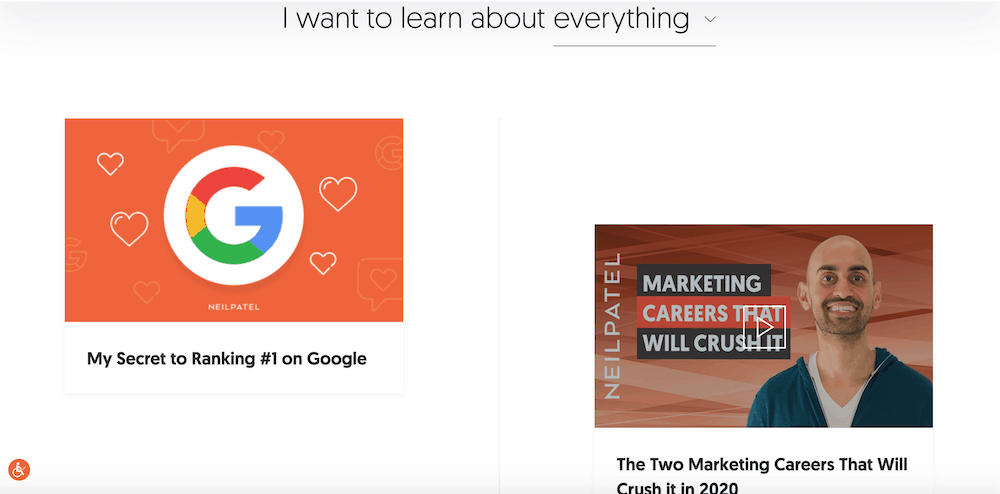
Now that we know where to post, let’s talk about what to post and how often.
Find the questions your customers are asking and answer them. Make every post focused entirely on providing value around a specific topic, not selling or pushing out press releases.
Nobody wants to read a press release.
If you answer questions and provide value, regardless of what industry you’re in, your marketing wheel will start rolling. This is a sure path to content your customers and Google will love.
To find the questions your customers are asking, use search engine research tools. You’ll be able to find the phrases relevant to your ideal customer that have a high search volume. High search volume means a lot of people have this issue. A lot of people with an issue translates into big $$$ if you can solve the problem.
I use SEMRush for all of my research. In my opinion, it’s the best tool on the market. I’m not just saying that because I’m an affiliate. It’s the opposite, I’m an affiliate because I believe in the product. I use SEMRush every single day.
Below you can see what the initial research for this post looked like on SEMRush. This screen capture shows the phrase, monthly search volume, how difficult the phrase is to rank for, and the cost per click if I want to advertise on Google ads (more on that later).
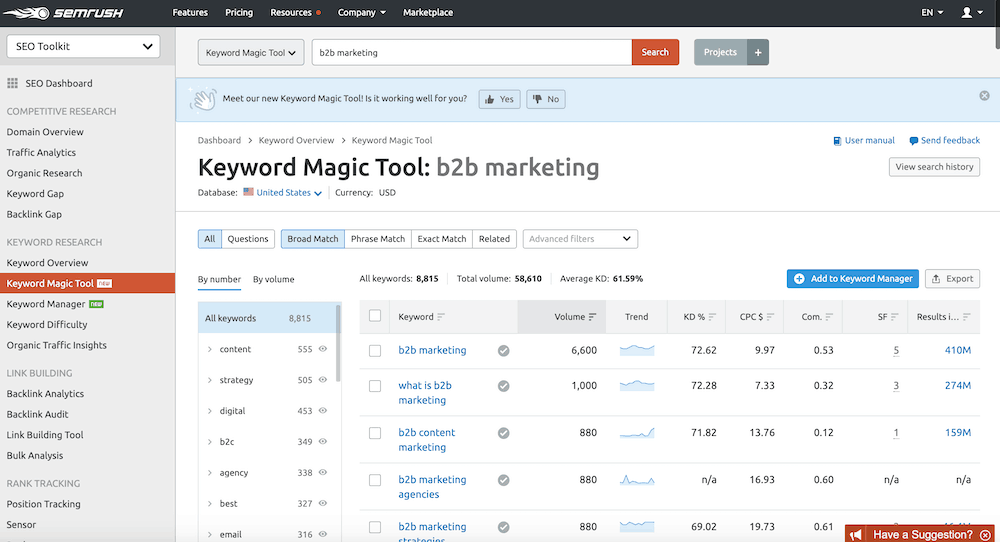
Now do your own research and start writing. Tackle a specific topic each week. Don’t try to cover multiple unrelated topics in one post. Break things up into clear topics Google and your readers can understand.
As for how often, you must put out a fresh post every single week (preferably on the same day each week) if you want to get traction. You can post more than once a week if you have the bandwidth, but I feel it’s crucial to build the habit of producing at least one post per week.
Your posts won’t be perfect at first. Honestly, you’ll probably suck at first. That’s ok. You’ll get better with every single post.
The key is to establish habits around producing and posting content. Start that marketing wheel rolling. It’s going to require a lot of hard work to get it moving, but once it’s rolling you have momentum on your side.
Here’s how you’ll get some awareness for your blog so you’re not always talking to an empty room…
Execution Step 2: Share Your Blog Post On LinkedIn
Focus on getting awareness where you know B2B customers are. LinkedIn is that channel for most businesses. Remember, the majority of B2B marketing efforts fail because businesses are trying to be on too many platforms. You can always spread to other platforms later. Right now, focus on being great on LinkedIn instead of mediocre on Instagram, Facebook, Twitter, and LinkedIn.
You’re going to create an irresistible LinkedIn post pushing people to your blog each time you release a new blog post.
The actual process for sharing on LinkedIn is simple. Start by hitting the “start a post” link at the top of your LinkedIn page.

Next, copy and paste your blog link into the space provided. Your blog post will magically pop into the screen.
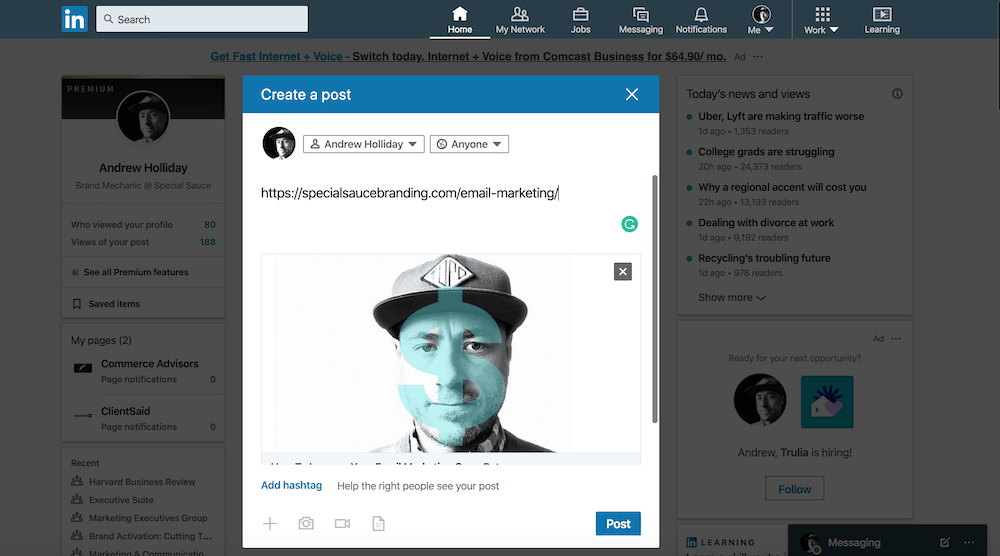
Erase the website link (don’t worry, your post will still be present). Replace that with a wonderful teaser for your article that demands attention. This is a crucial step to success on LinkedIn. Spend time making your post copy compelling. Think of this as advertising for that fantastic blog post you just spent a lot of time writing.
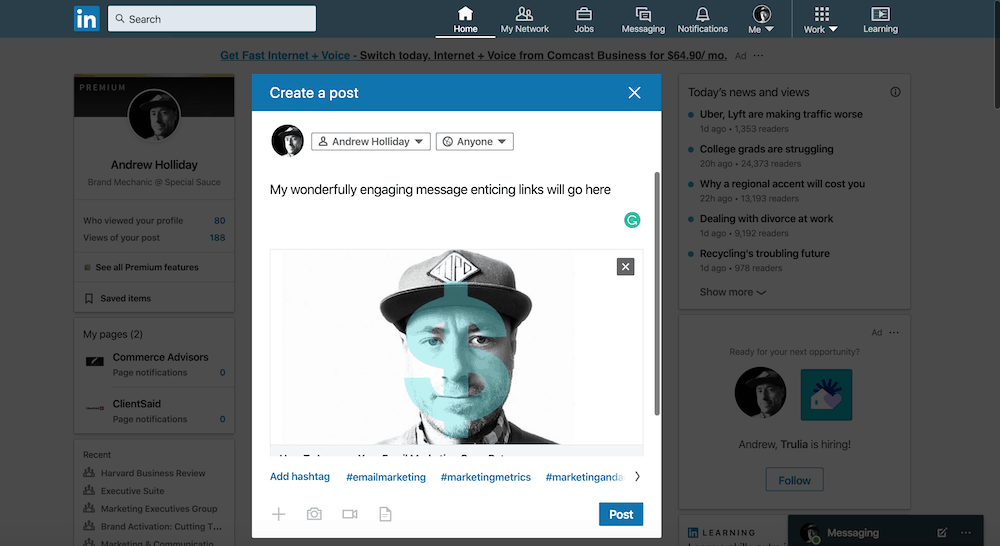
Bonus tip, make sure you have a photo associated with the post that will stand out in the LinkedIn feed for your blog post. Even if you don’t use photos in your blog, you should have an image associated with the post for sharing on social. This can be accomplished using the Yoast plugin for WordPress.
Here’s an example of a recent post that has racked up 2,400 views on LinkedIn and is driving steady traffic to my blog. This has all of the elements we just discussed.
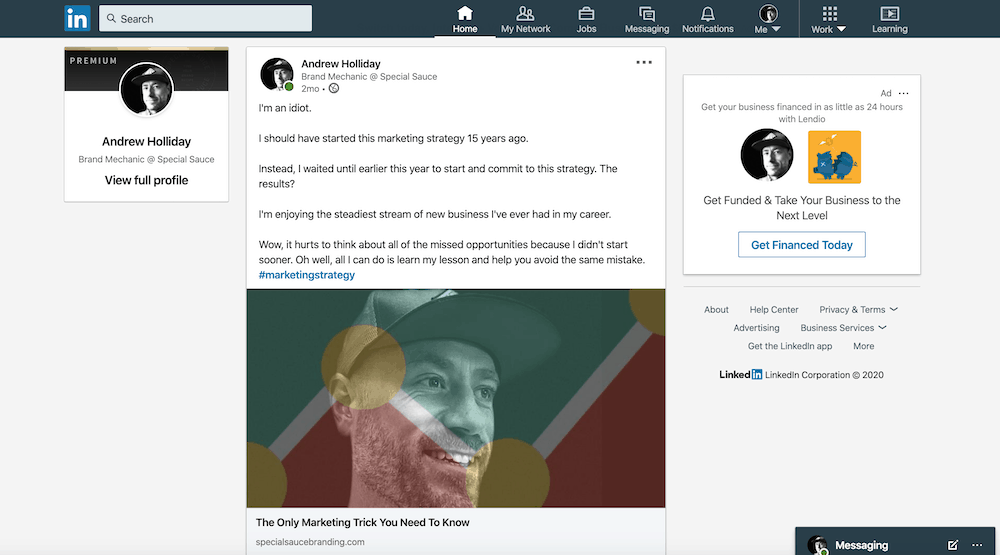
Don’t sweat it if some of your posts are a bust. Sometimes LinkedIn doesn’t push your post out to a wide audience and it sits quietly on your feed like a lonely kid on the playground.
That said, here’s a little trick you can use to give your posts a much better chance at distribution. Manually reach out to a few LinkedIn contacts who are friends and ask them to go like your fresh new LinkedIn post as soon as it goes live. This will often trigger the LinkedIn algorithm and result in much wider distribution.
Execution Step 3: Drive Targeted Traffic With Google Ads
Your eventual goal is to have a steady stream of visitors flowing in from Google for free, but it takes time to win the love of Google’s search engine algorithm using organic SEO. The good news is that Google’s love can be bought.
We’ll use Google Ads to drive some immediate awareness with your ideal customer. However, don’t send them to your home page like most businesses. Like we discussed above, find the search phrases that match problems you solve, write a post that answers the question or solves the problem, and then send people to that article, video, or podcast episode on your blog. Use Google ads to connect with all of the people searching for the problem you solve.
Learning how to use Google PPC (Pay Per Click) ads is a robust subject that I can’t cover inside this guide. I recommend signing up for SEMRush and taking advantage of their free training courses. I’ve gone through a couple of their courses and they’re far better than most I’ve paid to take.
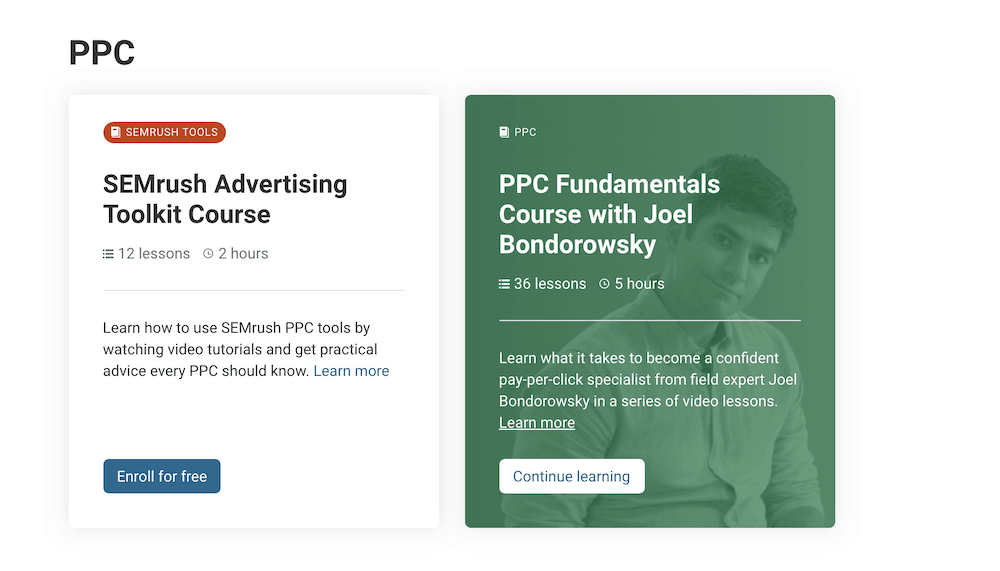
If you don’t want to learn PPC, hire someone to put this step in place for you. This is a perfect task to outsource to a PPC specialist. Pay them to do the initial research, set up your campaign, and then train you to take over management.
Setting up a thoughtful PPC campaign will help you get some immediate attention, awareness, and results while your organic traffic is growing.
Execution Step 4: Build Your Email List
The most lucrative marketing investment I’ve ever made is building an email list. If you get one thing from this article, please make it the importance of starting an email list today. Not tomorrow, start building it right this second.
I’ve landed an additional $100,000+ in work over the last year straight from my email list (and my list is small). No selling. No begging for work. I simply send a valuable email every Friday morning. Everyone on my email list is exposed to my expertise, learns my approach, gets a feel for who I am, and people tend to reach out when they have a problem that I can solve.
How much did sending those emails cost me? A whopping $240. I’m not good at math, but even I can tell you that a six-figure return on a $240 investment is pretty solid.
Hopefully, you’re on board with the importance of building a B2B email marketing list. Let’s get into exactly how you make it happen. I’ll start with what you’re not going to do, send a newsletter.
Nobody wants to sign up for your newsletter. What people do want is inspiration, motivation, information, and answers.
We’re going to give them this in the form of a weekly email brand. A weekly email brand is an email with a specific purpose marketed on your website and sent every week on the same day. Your email brand is separate from your company brand. The two obviously need to be related, but the email should provide value on its own.
Set up a page on your website dedicated completely to your email brand. This page has one purpose, get people on your email list.
The below example for Sticky Notes from Cole Schafer of Honey Copy is an example of exactly how you should build an email brand and market it on your website.
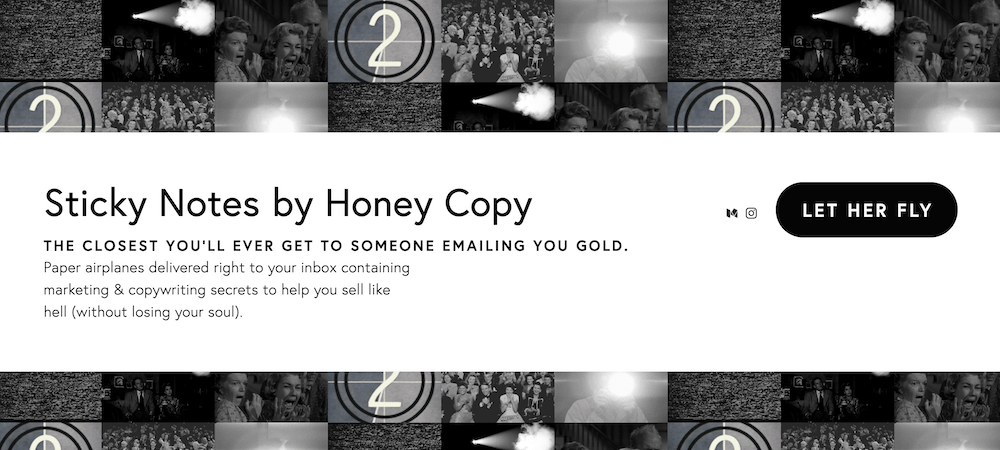
Cole’s email acquisition page makes you want more. He presents a clear value proposition and he does so with personality.
Next, we’re going to link this email acquisition page to an email marketing service. I use Mailchimp, but there are numerous options. I’ll provide some links and notes to these in the Marketing Tools chapter that follows.
Whichever service you choose, the steps are the same. Sign up for an account, set up a new audience, and create an automated welcome email that is sent every time someone signs up for your list. Go sign up for The Recipe if you want a taste of how this works.
That brings us back to your blog posts where we’re sending people from Google and LinkedIn. In short, getting people on your email list is the one goal we have with all of those other efforts. We’re going to include a call to action at the end of every blog post pushing people to your email acquisition page. Let’s stick with Cole to see how all of his posts lead you to his email.
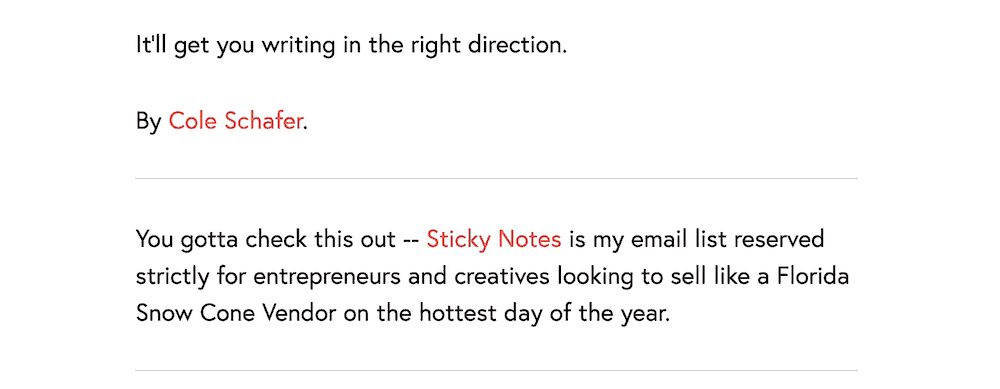
Compliment the callouts in blog posts with a popup acquisition and/or overlay bar. Here’s the one I use on my site.
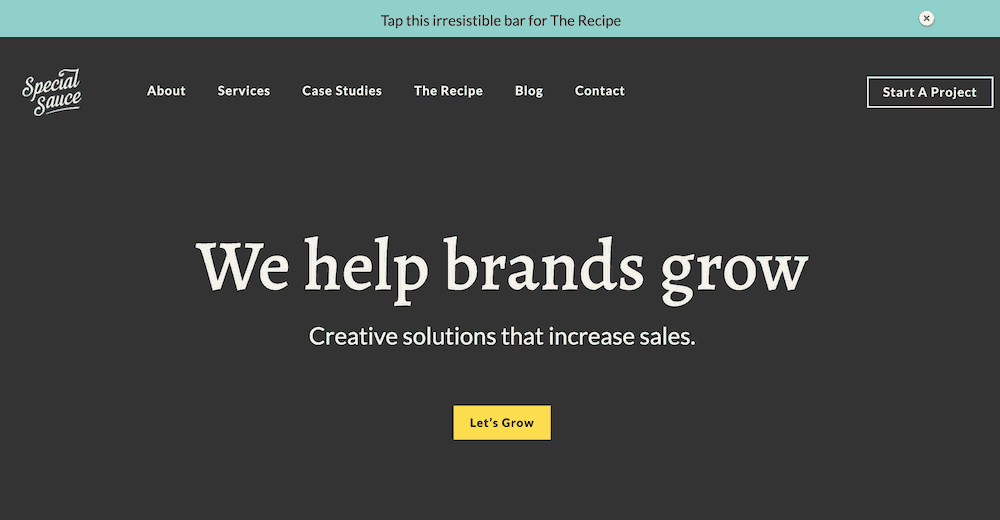
That colorful bar at the top gently nudges people to my email acquisition page. You can steal this strategy to steadily build your list.
Earning someone’s email address is a sign that there’s interest there and trust building. Now we just need to keep showing up in their inbox every week to prove our expertise and get the sale.
Execution Step 5: Nurture With Expertise Until They’re Ready To Buy
“Just showing up is half the battle”.
– Woody Allen
Everyone on my list knows they’ll get an email every Friday. And if they forget, they get a reminder on Friday. In short, I show up for battle every week.
Why does showing up every week matter? Because I’m steadily persuading the right people of my expertise. Notice I said “the right people” in the previous sentence. Not everyone on my list will turn into a customer.
In fact, some people on my list will unsubscribe. It’s a common occurrence for anyone who sends emails. Maybe they don’t like my methodologies. Maybe they don’t like my email formatting. Maybe they just don’t like me.
Whatever the case, a few people unsubscribing is actually a good thing (as much as I hate that I didn’t hold their attention), it’s saving me money and allowing me to focus on those unicorn clients who do love my emails and soak up every bit of advice.
Each week, try to send your audience the best damn email (about your niche) they get all week. Make them feel like they should be paying for the email because it’s so valuable.
Over time, the benefits will start to show. You’ll get a referral here, a project inquiry there, and all of this momentum turns your AITAR marketing wheel into an unstoppable force.
Execution Step 6: Solve Their Problem
Yes, delivering your product or service is part of your marketing. We talked about this in Chapter 1, but it’s important to show exactly where this fits in your ongoing execution.
It fits right here.
You’ve nurtured a prospect along and gotten the sale. Now it’s time to deliver on your promises.
Obsess on the results your clients and customers achieve. If you solve their problem, they’ll buy more, they’ll tell their friends, and you’ll develop a reputation as an expert who can solve big hairy problems for your ideal customer.
Execution Step 7: Send A Professional Follow Up Sequence
Finishing projects strong has been one of the biggest differentiators for my business. Anyone can do this, but the majority of B2B companies don’t. This is an opportunity for you to separate from the competition. Finish strong and send a professional follow up sequence while excitement is high with your customer.
I’m not kidding, you’ll be amazed at what the simple combination of finishing strong and following up while excitement is high can do for your business.
We’ve covered this action step thoroughly above in Chapter 1. Go back and read that chapter for a refresher on how to drive testimonials and reviews.
Well, that’s the whole enchilada. It’s time to start executing.
Chapter 4: Action Items
- Pick your content marketing engine.
- Complete search engine research to find the questions your customers are asking.
- Build a content marketing schedule.
- Sign up for an email marketing service.
- Build your email acquisition page and welcome email.
- Start executing the AITAR steps and keep showing up every single week.
Helpful Resources: B2B Marketing Tools To Speed Your Progress
Before you head out, here’s a quick grab-bag of tools that will help you along your journey. This is a small sample of some of the most crucial tools and resources I use. Sign up for The Recipe if you’d like the inside scoop as I test new tools, methods, and books.
Email Marketing Services
Here are three of the top email marketing tools for consideration. You honestly can’t go wrong with any of these options.
Search Engine Research & Planning
You can start spitting out content and hope it’s solving a big hairy problem for someone, or you can get a tool that will tell you exactly what people are searching so you know you’re solving a big problem. I prefer the latter where there’s no doubt that you’re spending your time producing valuable content.
Client Review & Testimonial Tools
A professional follow up sequence is invaluable. I use ClientSaid after every project to gather reviews and testimonials. Like they say on the site, it’s cheap and easy. It’s one of the best investments in software you’ll make.
Marketing Books
These are some of the wonderful reads that have helped me grow as a marketer. I recommend them all.
Now Go Make Some Magic Money
You can take this guide and start executing the AITAR marketing wheel right now. If executed consistently, you’ll see results. If you don’t execute, you won’t see results. This system isn’t magic, but it’s pretty dang magical if you stick with it through the initial lulls.
Don’t expect to get through this guide in one sitting. Bookmark this page, bite off a little at a time, and then come back later. Focus on executing each chapter before moving on to the next.
If you struggle, feel free to reach out to me. I’m always happy to answer questions and provide a little feedback.
